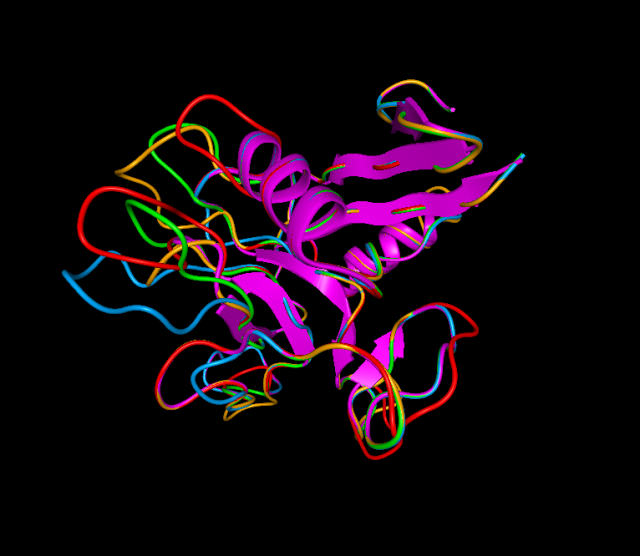Mar 13 2015
 Perlucin has several characteristic protein strands, here indicated by colored loops in a BallView model. They are assumed to cause the observed structural alterations in the calcium carbonate crystals.
Perlucin has several characteristic protein strands, here indicated by colored loops in a BallView model. They are assumed to cause the observed structural alterations in the calcium carbonate crystals.
Researchers in Saarbrücken and Haifa have shown that a single protein species can produce explicit effects on crystal structure formation.
Nacre is a very beautiful organic-inorganic composite material and is commonly used for decoration and jewellery. However, it also has a very fine layer structure with high hardness and strength.
It comprises naturally formed crystals, which have certain specific characteristics. This is the key reason for the industry trying to create the same kind of materials with the aid of biological models.
Haifa and Saarbrücken scientists have been able to imitate the combination of biopolymeric compounds and calcium carbonate, which in nature took so many millions of years and a large number of environmental parameters.
The scientists used a very simple technique by which it was established that one protein species alone can cause a specific influence on crystal structure formation. This very much simplifies the path to the application of biotechnology for producing crystalline materials having novel functions.
The nacre structure includes inorganic calcium carbonate layer lattices alternating with organic material layers. Proteins such as collagen, chitin and several others make sure that the growth of calcium carbonate takes place in these defined layers.
The role played by the proteins at the time of growth has not been elucidated before, however it was assumed that a number of proteins worked together to manipulate the calcium carbonate lattice structure and also they became a part of the nacreous layers.
However, Ingrid Weiss of the INM – Leibniz Institute for New Materials in Saarbrücken and her co-researcher Boaz Pokroy at the Technion Israel Institute of Technology have proved that it is possible to modify the calcium carbonate lattice structure by just one protein species.
“This finding simplifies matters and opens up new possibilities for white biotechnology. Until now, white biotechnology has labored under the idea that mineralization could not be recreated using biological models, because it was assumed that it took a combination of several proteins and a number of factors that were not readily understandable to make biomineralization possible.
Ingrid Weiss, INM’s Head of the Biomineralization Program
In case the natural processes were highly complex, they would not be deployed for industrial development. According to Weiss and Pokroy, it is definitely not that complex.
The protein perlucin was extracted from abalone (Haliotis) shells by the researchers and it was mixed with green fluorescent protein (GFP). By doing so, the insoluble perlucin was converted to a water-soluble form.
This solution was added at varying concentrations to a calcium carbonate solution and then the produced crystals were studied. The obtained results were evaluated with crystals obtained from a pure calcium carbonate solution and also crystals obtained from a calcium carbonate solution having GFP.
The dissolved perlucin alone was included in the inorganic carbonate lattice where it caused significant as well as a broad range of distortions to the lattice. The principle followed by this effect is “all or nothing”. Small protein quantities are already sufficient to cause definite lattice distortions. On the onset of distortion, it is continually reproduced across the lattice continually.
“GFP alone simply coexists with calcium carbonate – it surrounds the calcium carbonate lattice like a jacket without changing it”, explains the biomineralization expert. Similar to a shell, the perlucin impacts the structure and growth of the crystal lattice.
The INMs mussel protein expertise and the Institute of Haifa’s crystal analysis expertise were used by the researchers in order to describe this phenomenon. This combination helped study perlucin reactions in the crystal lattice.
The researchers are now keen on determining whether other proteins have specific impacts on the functionality and structure of inorganic crystal lattices.
The research findings have been published as a cover publication in the Chemistry of Materials journal.